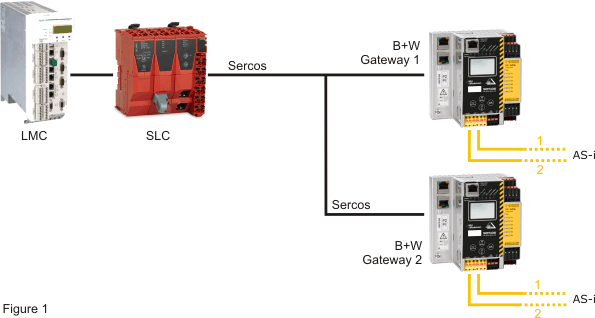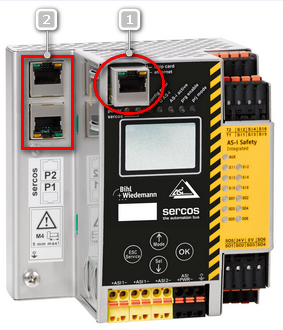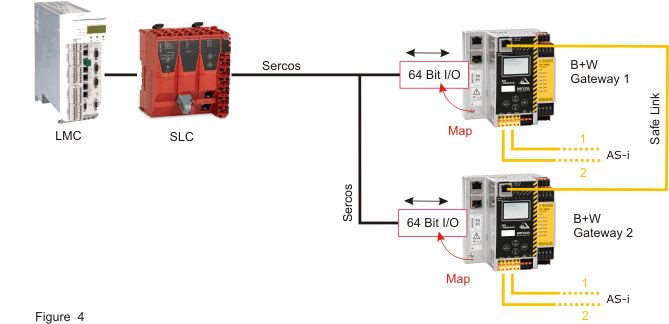Use case: Several AS-i Gateways in one SLC Safety Architecture
Up to five AS-i Gateway devices can be connected per Safety Logic Controller. Each integrated AS-i Gateway communicates via a '8 Bytes Safe Sercos Data' device object with the upstream SLC.
Keep in mind that the extension of your safety-related application by the AS-i field bus level may influence the function, performance, and overall response time of your application. You need to verify whether the various logics (Gateway, LMC, SLC) in the distributed controller application interact correctly.
WARNING
UNINTENDED EQUIPMENT OPERATION
Verify the interaction between the applications programmed for the AS-i Gateway (with its connected I/O devices) and the PacDrive 3 application (LMC and SLC programs).
Verify the mapping of AS-i I/O data to the '8 Bytes Safe Sercos Data' device object and the use of AS-i input/output data bits in the safety-related SLC application.
Be sure that the functional testing you perform comprises the entire system including the AS-i Gateway and I/O slaves, and corresponds to your risk analysis, and considers each possible operating mode and scenario the safety-related application should cover.
Observe the regulations given by relevant sector standards for the distributed automation system.
Use appropriate safety interlocks where personnel and/or equipment hazards exist.
Failure to follow these instructions can result in death, serious injury, or equipment damage.
In particular, the total safety response time of the entire system has to be inspected and verified precisely as the integration of the AS-i field bus with connected AS-i slaves extends the total safety response time.
WARNING
UNINTENDED EQUIPMENT OPERATION
Verify that the safety response time of the entire system includes the response times specific to the AS-i Gateway with its connected AS-i I/O devices.
Validate the total lag-time of the system and thoroughly test the application controlling for lag-time.
Failure to follow these instructions can result in death, serious injury, or equipment damage.
NOTE:
If several AS-i Gateways are used and interlinked in your safety-related application, you have to verify that the mapping of safety-related AS-i data to the data bits in one or several '8 Bytes Safe Sercos Data' device objects are documented in a comprehensible and clear way, thus ensuring the correct mapping and evaluation in the safety-related application.

Figure 1: two AS-i Gateways without cross-communication connected to one SLC
AS-i Gateways support cross-communication, thus enabling the integration and use of several AS-i Gateways in your safety-related application. Cross-communication between AS-i Gateways is possible via the openSafety-complying Safe Link protocol. Safe Link by Bihl+Wiedemann provides safety-related communication via Ethernet. This way, subnetworks can be interconnected and evaluated/monitored by the same Safety Logic Controller. The PacDrive 3 safety-related system supports a maximum of 5 AS-i Gateways.
Typically, the commissioning/diagnostic interface (RJ45 Ethernet port) of the AS-i Gateways is used to establish a Safe Link network (number (1) in figure 2 below). Although Safe Link can also be configured at the Sercos port (2), the use of the commissioning/diagnostic interface reduces the data traffic on the Sercos bus, thus saving bandwidth in the network, and reduces the system complexity.
Illustration: commissioning/diagnostic interface

Figure 2: commissioning/diagnostic interface of the AS-i Gateway
Do not exchange the same data between several AS-i Gateways (via Safe Link) and at the same time between SLC and several AS-i Gateways (via the '8 Bytes Safe Sercos Data' device object). Figure 3 below shows an example.
Connect only one AS-i Gateway (Gateway 1 in the example below) to the SLC.
Interconnect the other AS-i Gateway(s) (2 to 5) via Safe Link. These AS-i Gateways can cross-communicate with Gateway 1 which is connected to the Sercos bus.
Map the relevant safety-related AS-i data of all AS-i safety architectures (covered by all AS-i Gateways involved) to the '8 Bytes Safe Sercos Data' device object of Gateway 1.
This way the safety-relevant information is transferred only once to the SLC.

Figure 3: cross-communication between AS-i Gateways
If the architecture of your application combines the direct Sercos connection of several AS-i Gateways with Safe Link cross-communication as illustrated in figure 4 below, the bus cycle times for the data exchange between and the processing times in the controllers (AS-i Gateways and SLC) must be considered to avoid deadlock situations in your application.

Figure 4: cross-communication between AS-i Gateways via Safe Link and Sercos
Due to the potential ill effect of such an architecture, you may need to reconsider such an implementation in favor of one depicted in figure 3.